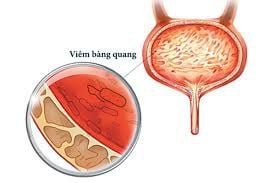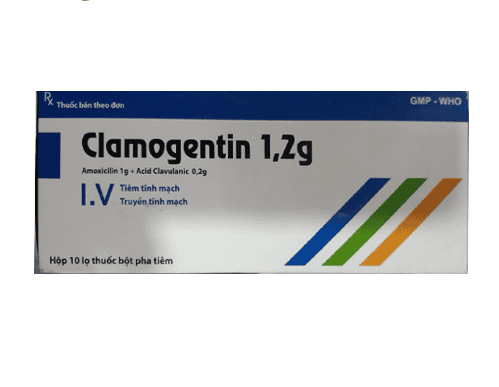This is an automatically translated article.
Enoxacin is an antibiotic, used in cases of bacterial infections. Often chosen for the treatment of genital and urinary tract infections. Taking the medicine according to the doctor's instructions will ensure the safety of the patient's health.1. What is Enoxacin?
Enoxacin is an antibiotic belonging to the fluoroquinolone group. The drug is prepared in the form of 200mg, 400mg film-coated tablets. Enoxacin has a bactericidal effect and the mechanism of action depends on the suppression of bacterial DNA replication by inhibiting the enzyme DNA gyrase (DNA Topoisomerase II). Enoxacin is a broad-spectrum antibiotic and it is active against both Gram-positive and Gram-negative bacteria.2. Uses of Enoxacin
Enoxacin has the effect of killing bacteria and is used in the treatment of bacterial infections. Enoxacin is indicated for use in adult infections such as:Uncomplicated acute cystitis in premenopausal women and complicated cystitis in women; Acute uncomplicated gonococcal urethritis in adults; Prostatitis caused by susceptible bacteria. Note that before choosing this drug to treat bacterial infections, it is necessary to pay attention to the ability of bacteria to resist enoxacin before starting treatment. If the disease is suspected to be caused by infection with Pseudomonas aeruginosa or Staphylococcus aureus, if there is a resistance mutation, it should be combined with another antibiotic.
Do not use Enoxacin in the following cases:
Hypersensitivity to the active ingredient Enoxacin, other Quinolones or to any of its ingredients; Epilepsy patients with a history of tendon disease related to the use of Quinolone antibiotics; Children or adolescents during the growth period, due to the drug are at risk of serious joint disease.
3. Dosage and how to use Enoxacin
Usage: Enoxacin is used orally. The tablet should be swallowed whole with a full glass of water. It is best to take the drug with meals to minimize gastrointestinal irritation.
Dosage in adults:
Uncomplicated acute cystitis in premenopausal women: The dose is 400 mg/day for 5 days; Complicated cystitis in women: Dosage 200mg x 2 times/day; Prostatitis: Use with a dose of 400mg x 2 times/day; Acute uncomplicated human gonococcal urethritis: 200 mg or 400 mg as a single dose depending on individual patient weight. Patients with renal impairment:
ClCr (creatinine clearance) ≥ 30ml/min: No dose adjustment needed; ClCr < 30ml/min: Only use Enoxacin in the treatment of prostatitis at a dose of 400 mg/day.
4. Enoxacin side effects
When taking Enoxacin you may encounter some side effects including:
Very common side effects: Diarrhea, increased alkaline phosphatase, rash, erythema; Common side effects: Urticaria, dizziness, headache, itching, sensitivity to light; Less common may be visual disturbances; Rare: Anaphylaxis, angioedema, tendon disorders such as Achilles tendinitis, tendon rupture; Very rare: Tachycardia, hyperglycemia, myalgia, arthralgia, paresthesia, depression, hallucinations, psychotic reactions, vasculitis, purpura, hypotension; Other side effects: Anemia, decreased white blood cell count, eosinophilia, thrombocytopenia, colitis, Stevens-Johnson syndrome. If serious side effects occur, you should stop taking the medicine and consult your doctor or seek medical attention immediately.
5. Notes when using Enoxacin
Some notes on the selection of antibiotics in the treatment of bacterial infections:
The drug may be susceptible to resistance by bacteria such as E.coli. the patient lived before use; Gonococcal urethritis can also be caused by strains of Neisseria gonorrhoeae resistant to the Quinolone group. Therefore, enoxacin should be used for the treatment of gonococcal urethritis only when the cause of resistant strains of Neisseria gonorrhoeae has been ruled out. When taking Enoxacin can cause photosensitivity. Exposure to sunlight or ultraviolet radiation should be avoided during treatment and for several days after treatment ends.
Tendonitis can lead to tendon rupture, especially the Achilles tendon. These tendon disorders can occur symmetrically, from the first 48 hours to several months after stopping fluoroquinolone therapy. The risk of tendon disease may be increased in elderly patients receiving concomitant corticosteroid therapy and in those regularly engaged in strenuous exercise. When signs of tendinitis appear, the drug should be stopped and examined for treatment.
Caution should be used in certain subjects such as patients with central nervous system disorders or other risk factors for epilepsy, psychosis or a history of mental disorders, diseases myasthenia gravis, prolongation of the QT interval.
In subjects with G6PD (glucose-6 phosphate dehydrogenase) deficiency, cases of acute hemolysis have been reported during treatment with Quinolone. Although no cases of hemolysis have been reported with Enoxacin, prescribing the drug to these patients should be weighed against the risks and alternative therapies should be used where possible.
Cases of paresthesias, dyskinesias, dyskinesias or myasthenia gravis have been reported in patients receiving Quinolones, including Enoxacin. Patients treated with Enoxacin should consult their physician if symptoms of neuropathy such as pain, burning, tingling, numbness, or weakness develop.
Pseudomembranous colitis and antibiotic-associated colitis have been observed with virtually all antibacterial agents, including enoxacin. The severity of the disease can vary, from mild to life-threatening. Therefore, it is important to consider the administration of enoxacin if signs of diarrhea occur during or after administration of any antibiotic. If you have drug-related colitis, you should stop using Enoxacin immediately, consult a doctor and get appropriate treatment.
As with other antibiotics, the use of enoxacin, especially for a long time, can increase the growth of non-susceptible strains of bacteria. If a secondary infection develops during treatment, appropriate measures should be taken.
Adhere to treatment in terms of dosage and usage to limit drug resistance.
For pregnant women: It is best not to use because of the risk to the fetus. Lactation: Contraindicated in nursing women, as Quinolones may pass into breast milk and pose a risk to the nursing infant.
Notes on drug use when driving and operating machinery: The drug can cause common side effects on the nervous system, so patients driving vehicles and using machines need to be careful. about this potential risk when starting the drug.
Interactions with other drugs may occur:
Duloxetine: Increased risk of side effects of Duloxetine because Enoxacin reduces metabolism in the liver; Theophylline: Decreased metabolism of Theophylline, leading to the risk of overdose; Vitamin K antagonists : Increased effect of vitamin K antagonist anticoagulants and risk of bleeding; Didanosine: Concomitant use of some fluoroquinolones with Didanosine may lead to the formation of insoluble complexes and an increase in gastric pH leading to decreased absorption of quinolones. Therefore, it is recommended to take Enoxacin at least 2 hours before or more than 2 hours after taking Didanosine. Glucocorticoids (except hydrocortisone in replacement therapy): May increase the risk of tendon disease, even tendon rupture, especially in patients on prolonged corticosteroid therapy. Ropinirole: Increased plasma concentrations of Ropinirole with signs similar to overdose due to decreased hepatic metabolism. Monitor clinical manifestations and reduce Ropinirole dose during treatment with enoxacin. Strontium: The combination reduces the absorption of Strontium from the gastrointestinal tract. Take Strontium away from Enoxacin by more than 2 hours if possible. Food interactions: Some foods that interact with this drug include caffeine, preparations containing magnesium, aluminum, calcium, iron, zinc or sucralfate... Enoxacin is an antibiotic to treat bacterial infections. should be used exactly as prescribed by the doctor. Monitoring side effects during treatment is essential to ensure safety for health.
Please dial HOTLINE for more information or register for an appointment HERE. Download MyVinmec app to make appointments faster and to manage your bookings easily.













